
The Ikon Gallery is an English gallery of contemporary art, located in Brindleyplace, Birmingham. It is housed in the Grade II listed, neo-Gothic former Oozells Street Board School, designed by John Henry Chamberlain in 1877.
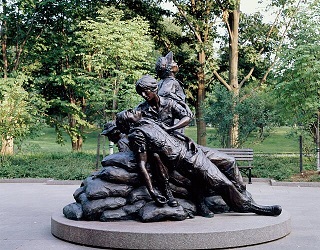
The Vietnam Women's Memorial is a memorial dedicated to the nurses and women of the United States who served in the Vietnam War. It depicts three uniformed women with a wounded male soldier to symbolize the support and caregiving roles that women played in the war as nurses and other specialists. It is part of the Vietnam Veterans Memorial and is located on the National Mall in Washington, D.C., a short distance south of the Wall and north of the Reflecting Pool. The statues are bronze and the base is made of granite. The United States Commission of Fine Arts and the National Capital Planning Commission selected Glenna Goodacre to sculpt the memorial after previously rejecting the idea for a memorial to women.

John Quincy Adams Ward was an American sculptor, whose most familiar work is his larger than life-size standing statue of George Washington on the steps of Federal Hall National Memorial in New York City.

The Martin Luther King, Jr. Memorial is a national memorial located in West Potomac Park next to the National Mall in Washington, D.C., United States. It covers four acres (1.6 ha) and includes the Stone of Hope, a granite statue of civil rights movement leader Martin Luther King Jr. carved by sculptor Lei Yixin. The inspiration for the memorial design is a line from King's "I Have a Dream" speech: "Out of the mountain of despair, a stone of hope." The memorial opened to the public on August 22, 2011, after more than two decades of planning, fundraising, and construction.
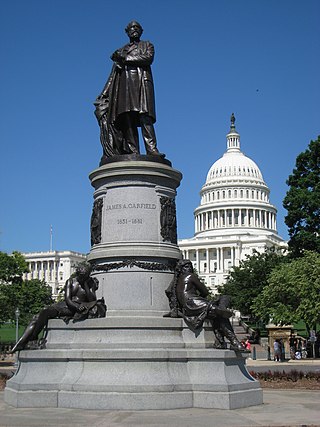
The James A. Garfield Monument stands on the grounds of the United States Capitol in Garfield Circle, a traffic circle at First Street and Maryland Avenue SW in Washington, D.C. It is a memorial to U.S. President James A. Garfield, who was elected in 1880 and assassinated in 1881 after serving only four months of his term. The perpetrator was an attorney and disgruntled office-seeker named Charles J. Guiteau. Garfield lived for several weeks after the shooting, but eventually succumbed to his injuries. The monument is part of a three-part sculptural group near the Capitol Reflecting Pool, including the Peace Monument and the Ulysses S. Grant Memorial in Union Square. The monument is also a contributing property to the National Mall and L'Enfant Plan, both of which are listed on the National Register of Historic Places and the District of Columbia Inventory of Historic Sites. The bronze statue rests on a granite pedestal that features three sculptures, each one representing a time period in Garfield's life.
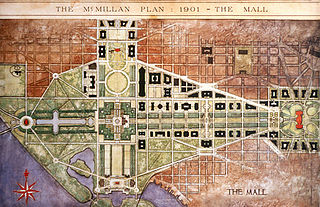
The McMillan Plan is a comprehensive planning document for the development of the monumental core and the park system of Washington, D.C., the capital of the United States. It was written in 1902 by the Senate Park Commission. The commission is popularly known as the McMillan Commission after its chairman, Senator James McMillan of Michigan.

The National Capital Planning Commission (NCPC) is a U.S. government executive branch agency that provides planning guidance for Washington, D.C., and the surrounding National Capital Region. Through its planning policies and review of development proposals, the Commission seeks to protect and enhance the resources of the U.S. national capital.

Willem Boshoff is one of South Africa's foremost contemporary artists and regularly exhibits nationally and internationally.

The Knoxville Museum of Art (KMA), is an art museum in Knoxville, Tennessee. It specializes in historical and contemporary art pieces from the East Tennessee region. According to its mission statement, the museum "celebrates the art and artists of East Tennessee, presents new art and new ideas, educates and serves a diverse community, enhances Knoxville’s quality of life, and operates ethically, responsibly, and transparently as a public trust."
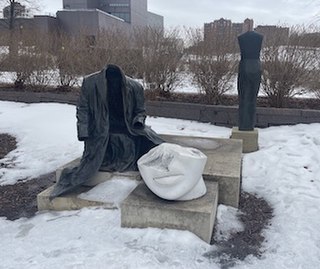
Judith Shea is an American sculptor and artist, born in Philadelphia, Pennsylvania, in 1948. She was awarded a degree in fashion design from the Parsons School of Design in 1969 and earned her Bachelor of Fine Arts degree there in 1975. This dual education formed the basis for her figure based works.

Paul Ramírez Jonas is an American artist and arts educator, who is known for his social practice artworks exploring the potential between artist, audience, artwork and public. Many of Ramirez Jonas's projects use pre-existing texts, models, or materials to reenact or prompt actions.
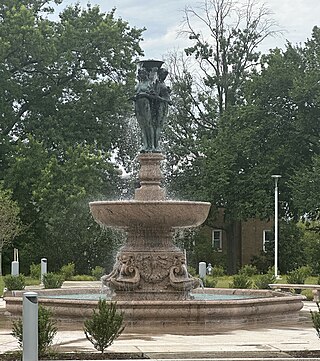
The McMillan Fountain is a public artwork by American artist Herbert Adams located on the McMillan Reservoir grounds. The fountain, completed in 1912, emplaced in 1913 and dedicated after October 1919, consists of a sculptural group of the Three Graces placed upon a pink granite base. Cast by Roman Bronze Works, the fountain was originally part of a large landscape setting designed by Charles A. Platt. It was dismantled in 1941 and moved to storage. The partially reconstructed fountain currently resides near its original location at McMillan Reservoir in the Bloomingdale neighborhood of Washington, D.C.
Tiffany Chung is a Vietnamese American contemporary artist who works primarily in thematic cartography and installation, and is also active in photography, painting, performance, sculpture, and other arts. Chung is globally noted for her interdisciplinary and research-based practice, with works and installations that examine conflict, geopolitical partitioning, spatial transformation, environmental crisis, displacement, and forced migration, across time and terrain.

Salamishah Margaret Tillet is an American scholar, writer, and feminist activist. She is the Henry Rutgers Professor of African American Studies and Creative Writing at Rutgers University–Newark, where she also directs the New Arts Justice Initiative. Tillet is also a contributing critic-at-large at The New York Times.

Wendy Red Star is an Apsáalooke contemporary multimedia artist born in Billings, Montana, in the United States. Her humorous approach and use of Native American images from traditional media draw the viewer into her work, while also confronting romanticized representations. She juxtaposes popular depictions of Native Americans with authentic cultural and gender identities. Her work has been described as "funny, brash, and surreal". Red Star was awarded a MacArthur Fellowship in 2024.
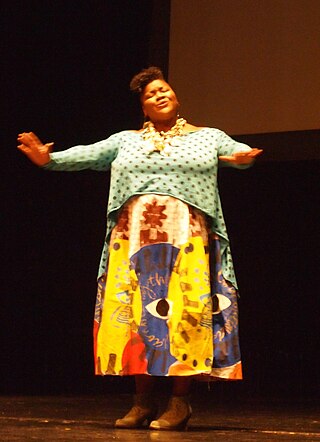
vanessa german is an American sculptor, painter, writer, activist, performer, and poet based in Pittsburgh, Pennsylvania.
Monument Lab is a public art project based in Philadelphia, Pennsylvania. Created by curators Paul Farber and Ken Lum and Director of Research Laurie Allen, the project is notable for producing a number of works of public art around the city of Philadelphia, often in collaboration with other organizations. In 2020, Mellon Foundation awarded Monument lab a three-year, $4 million grant to aid the Lab's mission.

Derrick Adams is an American visual and performance artist and curator. Much of Adams' work is centered around his Black identity, frequently referencing patterns, images, and themes of Black culture in America. Adams has additionally worked as a fine art professor, serving as a faculty member at Maryland Institute College of Art.
The Vessel Orchestra is a sound-based art installation created by British artist Oliver Beer. It is the first sound-oriented installation ever commissioned by the Metropolitan Museum of Art. The installation is composed of 32 objects from the museum's collection. Each object has a microphone placed in its hollow space in order to capture the natural sounds that each piece resonates. Beer chose each object for its unique pitch. For instance, a clay vase by Joan Miró resonates the musical note low F. The internal microphones, which do not touch the objects, are connected to a mixer, which is hooked up to a keyboard, therefore allowing a musician to "play" the objects, creating music. The installation was opened to the general public on July 2, 2019, and was on display at the Met Breuer until August 11, 2019. During the exhibit the installation played repeatedly a 20-minute loop of a composition by Beer. In addition, the instrument was played on Friday evenings during live music performances by guest musicians. The installation includes two and a half octaves in a chromatic scale, from low C to high G. It took Beer four years to create the installation. Some of the objects in the installation had never been on display in the museum before. The project was co-curated by Lauren Rosati and Limor Tomer.
















